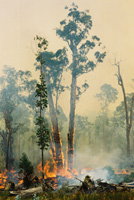FIRE INFORMATION
- NEWS
- National Fire News and News Releases
- Incident Management Situation Report (PDF)
- INCIWeb (external link)
- Statistics
- PIO Bulletin Board
- MULTIMEDIA
- Podcasts
- Videos
- Maps
- REFERENCES
- Producer's Guide: Featuring Wildland Fire on Television and Film
- International Support
- Military Support
- Science and Technology
- Contracting (external link)
- Wildland Fire Gear
- Reports and Investigations
International Support in Wildland Fire Suppression
 Australia and New Zealand’s assistance is authorized by the Wildfire Suppression Assistance Act (P.L. 101-11) emergency provision, which states: “with or without an agreement” the U.S. Government can request assistance from foreign fire agencies. This new arrangement will allow us to draw on the Australian fire agencies during critical fire seasons.
Australia and New Zealand’s assistance is authorized by the Wildfire Suppression Assistance Act (P.L. 101-11) emergency provision, which states: “with or without an agreement” the U.S. Government can request assistance from foreign fire agencies. This new arrangement will allow us to draw on the Australian fire agencies during critical fire seasons.
On September 9, 2001, the Secretaries of Agriculture and Interior signed an agreement with Australian Prime Minister John Howard for mutual assistance in firefighting between the United States and three states in Australia.
Similar command structures, training and physical requirements allow the New Zealand and Australian firefighters to easily blend into the upper level ranks of American wildland fire organizations.
2009
In February the United States sent three Burned Area Emergency Rehabilitation (BAER) teams, a 20 person crew and 15 fire specialists (a total of 73 personnel) to Australia. The last of these resources were released in early April.
The U.S. also provided one national Type 1 Incident management Team and 20 smokejumpers to British Columbia, Canada, in August.
2008
A total of 44 Australian fire operations specialists were utilized during the northern California fire siege. Â
Â
2007
 The US sent 67 specialists to help with fires in Australia. Â
The US sent 67 specialists to help with fires in Australia. Â
2006
US provided a Type 1 Incident Management Team (July 3 to July 16), three Type 1 crews, two Type 2 initial attack crews and miscellaneous overhead to the Canadian Interagency Forest Fire Center (CIFFC). These resources assisted the Province of British Columbia with its fire activity
Canada provided ten 20-person crews, 11 smokejumpers and 59 overhead to assist suppression operations in the US. Additionally up to 115 fire specialists and management personnel from Australia and New Zealand were assigned to western fires in August and September.
The Australian and New Zealand firefighters were demobed on Sept 17, 2006. Â
2003
 Through an established International Arrangement, 44 Australians and 10 New Zealanders were mobilized to the United States on August 27 and departed on September 15. These overhead resources were deployed to western Montana, filling critical command and operations management positions.
Through an established International Arrangement, 44 Australians and 10 New Zealanders were mobilized to the United States on August 27 and departed on September 15. These overhead resources were deployed to western Montana, filling critical command and operations management positions.
In January 2003, during the peak of the Australian fire season, a contingent of 36 US fire specialists was sent to the state of Victoria for a month along with an infrared aircraft. They arrived starting Jan 18 with the last person and the infrared aircraft returning March 2.
2002
150 people from Canada served in various overhead positions, and a total of 25 Canadian Type I crews helped fight wildfires. These crews represented an increase of about 30 percent of the number of Type I crews that were available to fight fire.
Fifty of the most highly trained and experienced firefighters from New Zealand and Australia arrived at NIFC on August 8, 2002 to help manage western wildland fires. These firefighters filled the most critical resource needs for fire suppression in the United States, which were for mid-level supervisors, and experienced aviation managers. This group includes 15 helicopter managers and 10 helibase managers. The ground firefighter supervisors were deployed on August 11 and the air operations firefighters were deployed on August 12 after an orientation at NIFC.
All the Australian and New Zealand firefighters went to fires in southwestern Oregon.
At their demobilization point on September 12, the Australian and New Zealand firefighters had completed two two-week assignments, with two days R&R between their assignments spent in Eureka, California.
2000
In 2000, over 500 individuals from Australia, New Zealand, Canada and Mexico assisted in fighting wildfires. Although fire management personnel from the United States, New Zealand and Australia have exchanged research, training, and technology for years, the summer of 2000 was the first time their firefighters fought fires on American soil.
2012 National Mobilization Guide
2012 "Red Book" and 2011 "Blue Book"
Sit Report and National Fire News
PIO Bulletin Board / Fire Season Podcasts
Join us on Twitter, Facebook,
You Tube, and Picasa:


